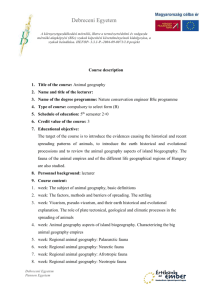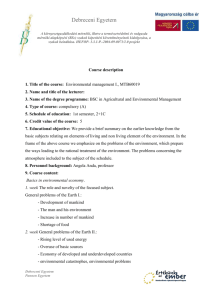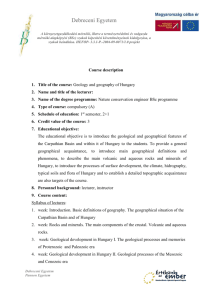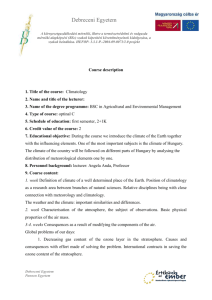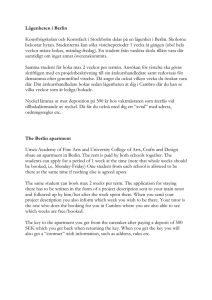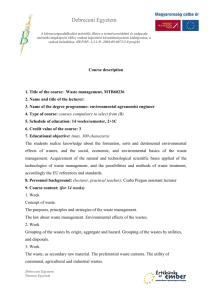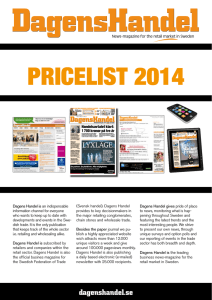Tantárgyi program - Debreceni Egyetem
advertisement
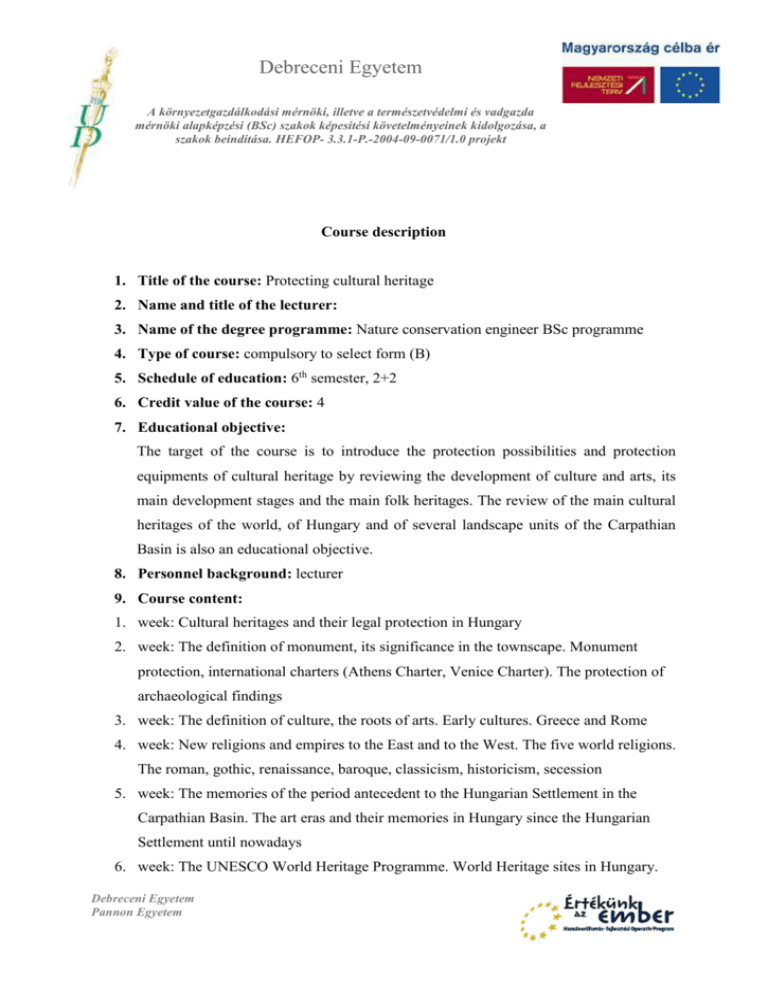
Debreceni Egyetem A környezetgazdálkodási mérnöki, illetve a természetvédelmi és vadgazda mérnöki alapképzési (BSc) szakok képesítési követelményeinek kidolgozása, a szakok beindítása. HEFOP- 3.3.1-P.-2004-09-0071/1.0 projekt Course description 1. Title of the course: Protecting cultural heritage 2. Name and title of the lecturer: 3. Name of the degree programme: Nature conservation engineer BSc programme 4. Type of course: compulsory to select form (B) 5. Schedule of education: 6th semester, 2+2 6. Credit value of the course: 4 7. Educational objective: The target of the course is to introduce the protection possibilities and protection equipments of cultural heritage by reviewing the development of culture and arts, its main development stages and the main folk heritages. The review of the main cultural heritages of the world, of Hungary and of several landscape units of the Carpathian Basin is also an educational objective. 8. Personnel background: lecturer 9. Course content: 1. week: Cultural heritages and their legal protection in Hungary 2. week: The definition of monument, its significance in the townscape. Monument protection, international charters (Athens Charter, Venice Charter). The protection of archaeological findings 3. week: The definition of culture, the roots of arts. Early cultures. Greece and Rome 4. week: New religions and empires to the East and to the West. The five world religions. The roman, gothic, renaissance, baroque, classicism, historicism, secession 5. week: The memories of the period antecedent to the Hungarian Settlement in the Carpathian Basin. The art eras and their memories in Hungary since the Hungarian Settlement until nowadays 6. week: The UNESCO World Heritage Programme. World Heritage sites in Hungary. Debreceni Egyetem Pannon Egyetem Debreceni Egyetem A környezetgazdálkodási mérnöki, illetve a természetvédelmi és vadgazda mérnöki alapképzési (BSc) szakok képesítési követelményeinek kidolgozása, a szakok beindítása. HEFOP- 3.3.1-P.-2004-09-0071/1.0 projekt 7. week: Museums and open-air museums in Hungary. Famous cemeteries, gravestones. 8. week: Hungarian folk architecture. 9. week: Folk art – applied arts – handicrafts. Folklore. Ethnography of the Carpathian Basin. 10. week: The traditional peasant culture and traditional farming. 11. week: Shepherd order, shepherd culture 12. week: Traditional folk crafts, equipments and raw materials 13. week: Equestrian traditions of the Hungarians 14. week: Traditionalism formerly and nowadays 10. Mode of assessment during the semester: none 11. Type of exam: terminal examination 12. Compulsory practice related to the course: The practices are contracted as an allday field trip to the Déri Museum, to buildings under monument protection in Debrecen, and the Shepherd Museum, the Körszín and the Visiting Centre of the Hortobágy National Park Directorate in Hortobágy 13. Compulsory and recommended literature: A művészet története Magyarországon. Budapest, 1983 Balassa-Ortutay (1980): Magyar néprajz. Corvina Kiadó. Budapest Ortutay, Gy. (ed. in chief) (1977): Magyar néprajzi lexikon 1-5. Akadémia Kiadó. Budapest Rakonczay, Z. (2002): Természetvédelem. Szaktudás Kiadó Ház. Budapest Szabó, A. (1997): Művészettörténet képekben. Alternatív Közgazdasági Gimnázium Kiadója Szabó, A. (1997): Művészettörténet vázlatokban. Veritas Kiadó Barabás, J. and Gilyén, N. (2004): Magyar népi építészet. Mezőgazda Kiadó. Budapest 14. Exam themes: Debreceni Egyetem Pannon Egyetem Debreceni Egyetem A környezetgazdálkodási mérnöki, illetve a természetvédelmi és vadgazda mérnöki alapképzési (BSc) szakok képesítési követelményeinek kidolgozása, a szakok beindítása. HEFOP- 3.3.1-P.-2004-09-0071/1.0 projekt 1. Delineate the legal background of the protection of cultural heritages and the important international monument protection charters. 2. Delineate the appearance of the protection of cultural heritages in the law of nature conservation. 3. Explain the definition of monument, and delineate the history of monument protection. 4. Delineate the significance of monument protection in forming the townscape. 5. Delineate the regulation related to the protection of archaeological finding. 6. Explain the definition of culture and arts; describe the ancient and the Bronze Age art. 7. Describe the art of Egypt, Mesopotamia and Israel. 8. Describe the art of India, China and Japan. 9. Describe the art of the Indian and tribal cultures. 10. Describe the Crete-Mycenae Greek, Etruscan and Roman art. 11. Describe the former Christian, Byzantine, Copt and Islam art. 12. Describe the art of the wandering, the Carolingian and the Otto period and the roman art. 13. Describe the gothic, renaissance, baroque and the classicism. 14. Describe the romanticism, historicism, academism, eclecticism and the secession. 15. Delineate the World Heritage Convention, its categories, the requirements of rating into these categories and the mode of acceptation. 16. Delineate the Hungarian World Heritage Sites and the candidates. 17. Compare the features of folk art, applied arts, and handicrafts. 18. Delineate the connection between man and his environment and how lifestyle affects arts. 19. Compare the traditional and modern lifestyles considering the connection between man and his environment. 20. Delineate the eras of the Hungarian folk architecture. Debreceni Egyetem Pannon Egyetem Debreceni Egyetem A környezetgazdálkodási mérnöki, illetve a természetvédelmi és vadgazda mérnöki alapképzési (BSc) szakok képesítési követelményeinek kidolgozása, a szakok beindítása. HEFOP- 3.3.1-P.-2004-09-0071/1.0 projekt 21. Delineate the Transdanubian house buildings of the Hungarian folk architecture and their main architecture features. 22. Delineate the hither Danube house buildings and their main architectural features. 23. Delineate and place the ethnical groups of the Carpathian Basin. 24. Delineate the traditions of grazing animal husbandry and its organizational structure. 25. Delineate the connection between traditional farming methods and nature. 26. Delineate the main folk crafts and their status nowadays. 27. Delineate the main raw materials used by the main folk crafts. 28. Delineate the main Hungarian open-air museums and other places presenting ethnographical values. 29. Delineate the equestrian tradition of the Hungarians. 30. Delineate the alteration of the function of traditionalism. Debreceni Egyetem Pannon Egyetem
